maintenance Lancia Thema 2012 Owner handbook (in English)
[x] Cancel search | Manufacturer: LANCIA, Model Year: 2012, Model line: Thema, Model: Lancia Thema 2012Pages: 316, PDF Size: 3.85 MB
Page 5 of 316
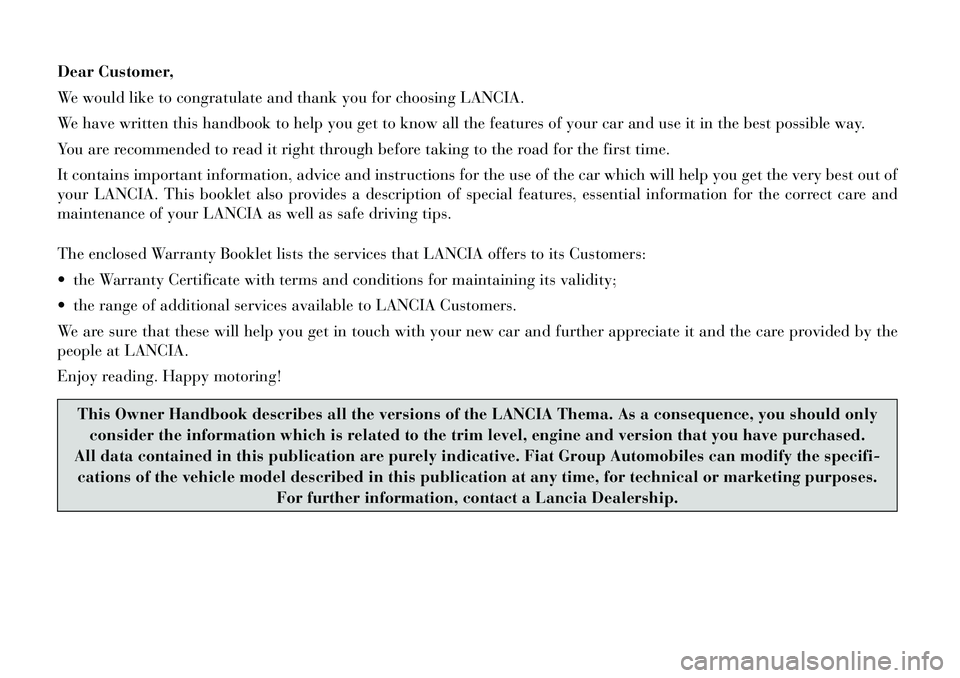
Dear Customer,
We would like to congratulate and thank you for choosing LANCIA.
We have written this handbook to help you get to know all the features of your car and use it in the best possible way.
You are recommended to read it right through before taking to the road for the first time.
It contains important information, advice and instructions for the use of the car which will help you get the very best out of
your LANCIA. This booklet also provides a description of special features, essential information for the correct care and
maintenance of your LANCIA as well as safe driving tips.
The enclosed Warranty Booklet lists the services that LANCIA offers to its Customers:
the Warranty Certificate with terms and conditions for maintaining its validity;
the range of additional services available to LANCIA Customers.
We are sure that these will help you get in touch with your new car and further appreciate it and the care provided by the
people at LANCIA.
Enjoy reading. Happy motoring!
This Owner Handbook describes all the versions of the LANCIA Thema. As a consequence, you should onlyconsider the information which is related to the trim level, engine and version that you have purchased.
All data contained in this publication are purely indicative. Fiat Group Automobiles can modify the specifi- cations of the vehicle model described in this publication at any time, for technical or marketing purposes.
For further information, contact a Lancia Dealership.
Page 7 of 316
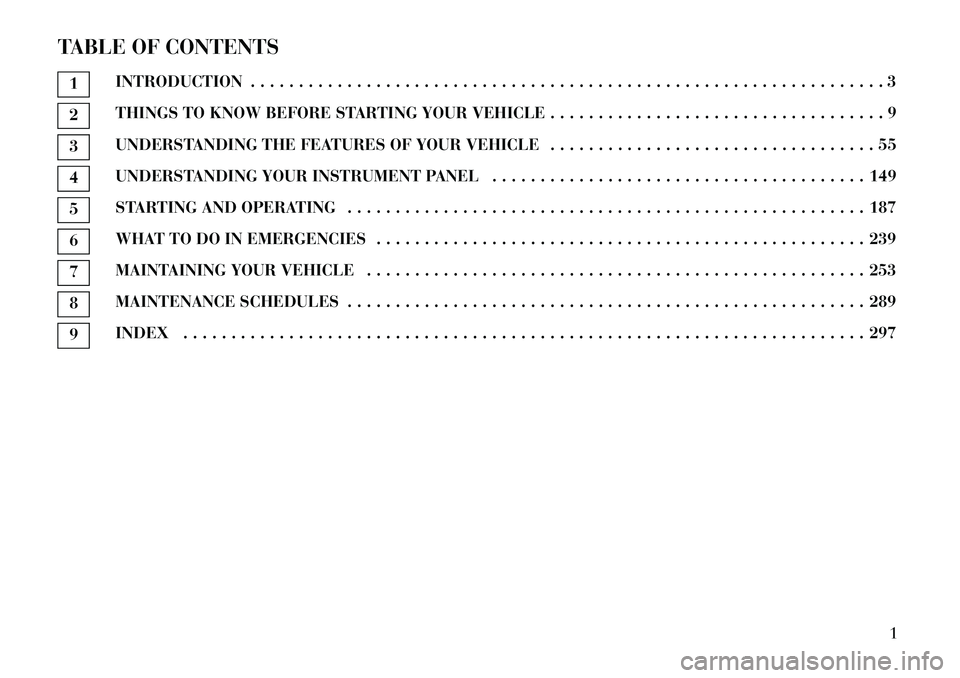
TABLE OF CONTENTS1INTRODUCTION . . . . . . . . . . . . . . . . . . . . . . . . . . . . . . . . . . . . . . . . . . . . . . . . . . . . . . . . . . . . . . . . . . 32THINGS TO KNOW BEFORE STARTING YOUR VEHICLE . . . . . . . . . . . . . . . . . . . . . . . . . . . . . . . . . . . 93UNDERSTANDING THE FEATURES OF YOUR VEHICLE . . . . . . . . . . . . . . . . . . . . . . . . . . . . . . . . . . 554UNDERSTANDING YOUR INSTRUMENT PANEL . . . . . . . . . . . . . . . . . . . . . . . . . . . . . . . . . . . . . . . 1495STARTING AND OPERATING . . . . . . . . . . . . . . . . . . . . . . . . . . . . . . . . . . . . . . . . . . . . . . . . . . . . . . 1876WHAT TO DO IN EMERGENCIES . . . . . . . . . . . . . . . . . . . . . . . . . . . . . . . . . . . . . . . . . . . . . . . . . . . 2397MAINTAINING YOUR VEHICLE . . . . . . . . . . . . . . . . . . . . . . . . . . . . . . . . . . . . . . . . . . . . . . . . . . . . 2538MAINTENANCE SCHEDULES . . . . . . . . . . . . . . . . . . . . . . . . . . . . . . . . . . . . . . . . . . . . . . . . . . . . . . 2899INDEX . . . . . . . . . . . . . . . . . . . . . . . . . . . . . . . . . . . . . . . . . . . . . . . . . . . . . . . . . . . . . . . . . . . . . . . 297
1
Page 10 of 316

INTRODUCTION
Congratulations on selecting your
new LANCIA vehicle. Be assured that
it represents precision workmanship,
distinctive styling, and high quality -
all essentials that are traditional to
our vehicles.
Before you start to drive this vehicle,
read this Owner's Manual and all the
supplements. Be sure you are familiar
with all vehicle controls, particularly
those used for braking, steering, and
transmission shifting. Learn how your
vehicle handles on different road sur-
faces. Your driving skills will improve
with experience, but as in driving any
vehicle, take it easy as you begin. Al-
ways observe local laws wherever you
drive.
NOTE:
After reviewing the owner infor-
mation, it should be stored in the
vehicle for convenient referencing
and remain with the vehicle when
sold.
Failure to operate this vehicle cor-
rectly may result in loss of control or a
collision.Operating this vehicle at excessive
speeds or while intoxicated may result
in loss of control, collision with other
vehicles or objects, going off the road,
or overturning; any of which may lead
to serious injury or death. Also, failure
to use seat belts subjects the driver
and passengers to a greater risk of
injury or death.
To keep your vehicle running at its
best, have your vehicle serviced at
recommended intervals by an autho-
rized dealer who has the qualified per-
sonnel, special tools, and equipment
to perform all service.
The manufacturer and its distributors
are vitally interested in your complete
satisfaction with this vehicle. If you
encounter a service or warranty prob-
lem, which is not resolved to your
satisfaction, discuss the matter with
your dealer's management.
Your authorized dealer will be happy
to assist you with any questions about
your vehicle.
IMPORTANT NOTICE
ALL MATERIAL CONTAINED IN
THIS PUBLICATION IS BASED ON
THE LATEST INFORMATION
AVAILABLE AT TIME OF PUBLI-
CATION APPROVAL. THE RIGHT
IS RESERVED TO PUBLISH REVI-
SIONS AT ANY TIME.
This Owner's Manual has been pre-
pared with the assistance of service
and engineering specialists to ac-
quaint you with the operation and
maintenance of your new vehicle. It is
supplemented by a Warranty Infor-
mation Booklet and various
customer-oriented documents. You
are urged to read these publications
carefully. Following the instructions
and recommendations in this Owner's
Manual will help assure safe and en-
joyable operation of your vehicle.
After you have read the Owner’s
Manual, it should be stored in the
vehicle for convenient reference and
remain with the vehicle when sold.
The manufacturer reserves the right
to make changes in design and speci-
fications, and/or to make additions to
4
Page 47 of 316
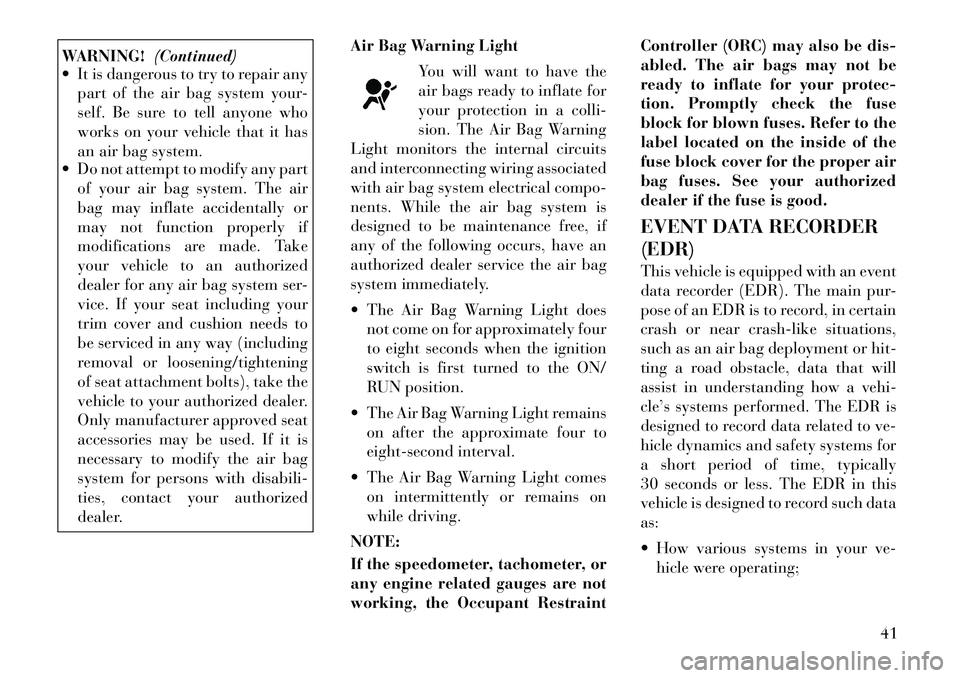
WARNING!(Continued)
It is dangerous to try to repair any
part of the air bag system your-
self. Be sure to tell anyone who
works on your vehicle that it has
an air bag system.
Do not attempt to modify any part
of your air bag system. The air
bag may inflate accidentally or
may not function properly if
modifications are made. Take
your vehicle to an authorized
dealer for any air bag system ser-
vice. If your seat including your
trim cover and cushion needs to
be serviced in any way (including
removal or loosening/tightening
of seat attachment bolts), take the
vehicle to your authorized dealer.
Only manufacturer approved seat
accessories may be used. If it is
necessary to modify the air bag
system for persons with disabili-
ties, contact your authorized
dealer. Air Bag Warning Light
You will want to have the
air bags ready to inflate for
your protection in a colli-
sion. The Air Bag Warning
Light monitors the internal circuits
and interconnecting wiring associated
with air bag system electrical compo-
nents. While the air bag system is
designed to be maintenance free, if
any of the following occurs, have an
authorized dealer service the air bag
system immediately.
The Air Bag Warning Light does not come on for approximately four
to eight seconds when the ignition
switch is first turned to the ON/
RUN position.
The Air Bag Warning Light remains on after the approximate four to
eight-second interval.
The Air Bag Warning Light comes on intermittently or remains on
while driving.
NOTE:
If the speedometer, tachometer, or
any engine related gauges are not
working, the Occupant Restraint Controller (ORC) may also be dis-
abled. The air bags may not be
ready to inflate for your protec-
tion. Promptly check the fuse
block for blown fuses. Refer to the
label located on the inside of the
fuse block cover for the proper air
bag fuses. See your authorized
dealer if the fuse is good.
EVENT DATA RECORDER
(EDR)
This vehicle is equipped with an event
data recorder (EDR). The main pur-
pose of an EDR is to record, in certain
crash or near crash-like situations,
such as an air bag deployment or hit-
ting a road obstacle, data that will
assist in understanding how a vehi-
cle’s systems performed. The EDR is
designed to record data related to ve-
hicle dynamics and safety systems for
a short period of time, typically
30 seconds or less. The EDR in this
vehicle is designed to record such data
as:
How various systems in your ve-
hicle were operating;
41
Page 56 of 316
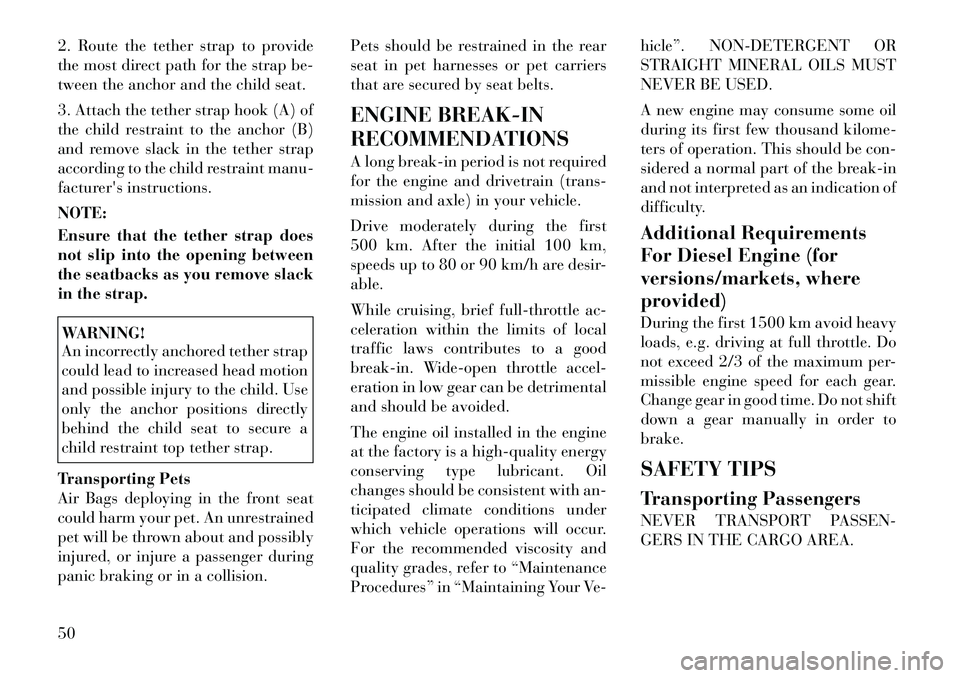
2. Route the tether strap to provide
the most direct path for the strap be-
tween the anchor and the child seat.
3. Attach the tether strap hook (A) of
the child restraint to the anchor (B)
and remove slack in the tether strap
according to the child restraint manu-
facturer's instructions.
NOTE:
Ensure that the tether strap does
not slip into the opening between
the seatbacks as you remove slack
in the strap.WARNING!
An incorrectly anchored tether strap
could lead to increased head motion
and possible injury to the child. Use
only the anchor positions directly
behind the child seat to secure a
child restraint top tether strap.
Transporting Pets
Air Bags deploying in the front seat
could harm your pet. An unrestrained
pet will be thrown about and possibly
injured, or injure a passenger during
panic braking or in a collision. Pets should be restrained in the rear
seat in pet harnesses or pet carriers
that are secured by seat belts.
ENGINE BREAK-IN
RECOMMENDATIONS
A long break-in period is not required
for the engine and drivetrain (trans-
mission and axle) in your vehicle.
Drive moderately during the first
500 km. After the initial 100 km,
speeds up to 80 or 90 km/h are desir-
able.
While cruising, brief full-throttle ac-
celeration within the limits of local
traffic laws contributes to a good
break-in. Wide-open throttle accel-
eration in low gear can be detrimental
and should be avoided.
The engine oil installed in the engine
at the factory is a high-quality energy
conserving type lubricant. Oil
changes should be consistent with an-
ticipated climate conditions under
which vehicle operations will occur.
For the recommended viscosity and
quality grades, refer to “Maintenance
Procedures” in “Maintaining Your Ve-hicle”. NON-DETERGENT OR
STRAIGHT MINERAL OILS MUST
NEVER BE USED.
A new engine may consume some oil
during its first few thousand kilome-
ters of operation. This should be con-
sidered a normal part of the break-in
and not interpreted as an indication of
difficulty.
Additional Requirements
For Diesel Engine (for
versions/markets, where
provided)
During the first 1500 km avoid heavy
loads, e.g. driving at full throttle. Do
not exceed 2/3 of the maximum per-
missible engine speed for each gear.
Change gear in good time. Do not shift
down a gear manually in order to
brake.
SAFETY TIPS
Transporting Passengers
NEVER TRANSPORT PASSEN-
GERS IN THE CARGO AREA.
50
Page 65 of 316
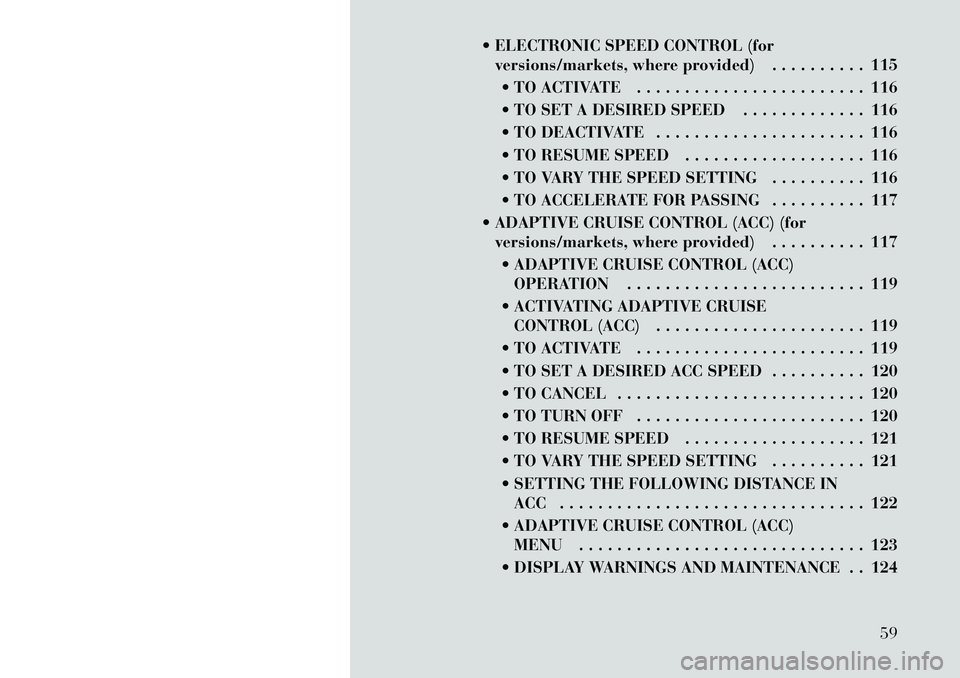
ELECTRONIC SPEED CONTROL (forversions/markets, where provided) . . . . . . . . . . 115
TO ACTIVATE . . . . . . . . . . . . . . . . . . . . . . . . 116
TO SET A DESIRED SPEED . . . . . . . . . . . . . 116
TO DEACTIVATE . . . . . . . . . . . . . . . . . . . . . . 116
TO RESUME SPEED . . . . . . . . . . . . . . . . . . . 116
TO VARY THE SPEED SETTING . . . . . . . . . . 116
TO ACCELERATE FOR PASSING . . . . . . . . . . 117
ADAPTIVE CRUISE CONTROL (ACC) (for versions/markets, where provided) . . . . . . . . . . 117
ADAPTIVE CRUISE CONTROL (ACC) OPERATION . . . . . . . . . . . . . . . . . . . . . . . . . 119
ACTIVATING ADAPTIVE CRUISE CONTROL (ACC) . . . . . . . . . . . . . . . . . . . . . . 119
TO ACTIVATE . . . . . . . . . . . . . . . . . . . . . . . . 119
TO SET A DESIRED ACC SPEED . . . . . . . . . . 120
TO CANCEL . . . . . . . . . . . . . . . . . . . . . . . . . . 120
TO TURN OFF . . . . . . . . . . . . . . . . . . . . . . . . 120
TO RESUME SPEED . . . . . . . . . . . . . . . . . . . 121
TO VARY THE SPEED SETTING . . . . . . . . . . 121
SETTING THE FOLLOWING DISTANCE IN ACC . . . . . . . . . . . . . . . . . . . . . . . . . . . . . . . . 122
ADAPTIVE CRUISE CONTROL (ACC) MENU . . . . . . . . . . . . . . . . . . . . . . . . . . . . . . 123
DISPLAY WARNINGS AND MAINTENANCE . . 124
59
Page 67 of 316

OPENING SUNROOF — EXPRESS . . . . . . . . . 136
OPENING SUNROOF — MANUAL MODE . . . . 136
CLOSING SUNROOF — EXPRESS . . . . . . . . . 136
CLOSING SUNROOF — MANUAL MODE . . . . 136
PINCH PROTECT FEATURE . . . . . . . . . . . . . 137
PINCH PROTECT OVERRIDE . . . . . . . . . . . . 137
VENTING SUNROOF — EXPRESS . . . . . . . . . 137
SUNSHADE OPERATION . . . . . . . . . . . . . . . . 137
WIND BUFFETING . . . . . . . . . . . . . . . . . . . . 137
SUNROOF MAINTENANCE . . . . . . . . . . . . . . 137
IGNITION OFF OPERATION . . . . . . . . . . . . . 137
COMMANDVIEW® SUNROOF WITH POWER SHADE — (for versions/markets, where
provided) . . . . . . . . . . . . . . . . . . . . . . . . . . . . . . 138
OPENING SUNROOF — EXPRESS . . . . . . . . . 138
OPENING SUNROOF — MANUAL MODE . . . . 138
CLOSING SUNROOF — EXPRESS . . . . . . . . . 138
CLOSING SUNROOF — MANUAL MODE . . . . 139
OPENING POWER SHADE — EXPRESS . . . . 139
OPENING POWER SHADE — MANUAL MODE . . . . . . . . . . . . . . . . . . . . . . . . . . . . . . 139
CLOSING POWER SHADE — EXPRESS . . . . 139
CLOSING POWER SHADE — MANUAL MODE . . . . . . . . . . . . . . . . . . . . . . . . . . . . . . 139
PINCH PROTECT FEATURE . . . . . . . . . . . . . 139
PINCH PROTECT OVERRIDE . . . . . . . . . . . . 139
61
Page 68 of 316

WIND BUFFETING . . . . . . . . . . . . . . . . . . . . 139
SUNROOF MAINTENANCE . . . . . . . . . . . . . . 140
IGNITION OFF OPERATION . . . . . . . . . . . . . 140
SUNROOF FULLY CLOSED . . . . . . . . . . . . . . 140
ELECTRICAL POWER OUTLETS . . . . . . . . . . . 140
CUPHOLDERS . . . . . . . . . . . . . . . . . . . . . . . . . . 142 FRONT SEAT CUPHOLDERS . . . . . . . . . . . . . 142
REAR SEAT CUPHOLDERS . . . . . . . . . . . . . . 142
STORAGE . . . . . . . . . . . . . . . . . . . . . . . . . . . . . 143 GLOVEBOX STORAGE . . . . . . . . . . . . . . . . . 143
CONSOLE FEATURES . . . . . . . . . . . . . . . . . . 143
DOOR STORAGE . . . . . . . . . . . . . . . . . . . . . . 144
REAR SEAT ARMREST STORAGE (forversions/markets, where provided) . . . . . . . . 144
CARGO AREA — VEHICLES EQUIPPED WITH 60/40 SPLIT-FOLDING REAR SEAT . . 144
CARGO AREA FEATURES . . . . . . . . . . . . . . . . . 145 TRUNK MAT (for versions/markets, whereprovided) . . . . . . . . . . . . . . . . . . . . . . . . . . . . 145
GROCERY BAG HOOKS . . . . . . . . . . . . . . . . . 145
REAR WINDOW FEATURES . . . . . . . . . . . . . . . 145 REAR WINDOW DEFROSTER . . . . . . . . . . . . 145
POWER SUNSHADE (for versions/markets,where provided) . . . . . . . . . . . . . . . . . . . . . . . 146
LOAD LEVELING SYSTEM (for versions/ markets, where provided) . . . . . . . . . . . . . . . . . 147
62
Page 130 of 316

DISPLAY WARNINGS AND
MAINTENANCE
“Clean Radar Sensor In Front Of
Vehicle” Warning
The ACC “Clean Radar Sensor In
Front Of Vehicle” warning will dis-
play when conditions temporarily
limit system performance. This most
often occurs at times of poor visibility,
such as in snow or heavy rain. The
ACC system may also become tempo-
rarily blinded due to obstructions,
such as mud, dirt or ice. In these
cases, the EVIC will display “Clean
Radar Sensor In Front Of Vehicle”
and the system will deactivate.
The “Clean Radar Sensor In Front Of
Vehicle” message can sometimes be
displayed while driving in highly re-
flective areas (i.e. tunnels with reflec-
tive tiles, or ice and snow). The ACC
system will recover after the vehicle
has left these areas. Under rare condi-
tions, when the radar is not tracking
any vehicles or objects in its path this
warning may temporarily occur.NOTE:
If the ACC “Clean Radar Sensor In
Front Of Vehicle” warning is active
Normal (Fixed Speed) Cruise Con-
trol is still available. For addi-
tional information refer to “Nor-
mal (Fixed Speed) Cruise Control
Mode” in this section.
If weather conditions are not a factor,
the driver should examine the sensor.
It may require cleaning or removal of
an obstruction. The sensor is located
in the center of the vehicle behind the
lower grille.
To keep the ACC System operating
properly, it is important to note the
following maintenance items:
Always keep the sensor clean. Care-
fully wipe the sensor lens with a soft
cloth. Be cautious not to damage
the sensor lens.
Do not remove any screws from the sensor. Doing so could cause an
ACC system malfunction or failure
and require a sensor realignment.
If the sensor is damaged due to a collision, see your authorized dealer
for service. Do not attach or install any acces-
sories near the sensor, including
transparent material or aftermar-
ket grilles. Doing so could cause an
ACC system failure or malfunction.
When the condition that deactivated
the system is no longer present, the
system will return to the “Adaptive
Cruise Control Off” state and will re-
sume function by simply reactivating
it.
NOTE:
Installing a vehicle front-end pro-
tector or an aftermarket grille or
modifying the grille is not recom-
mended. Doing so may block the
sensor and inhibit ACC operation.
ACC Unavailable Warning
If the system turns off, and the EVIC
displays “Adaptive Cruise Control
(ACC) Unavailable”, there may be a
temporary malfunction that limits
ACC functionality. Although the ve-
hicle is still drivable under normal
conditions, ACC will be temporarily
unavailable. If this occurs, try activat-
124
Page 143 of 316

PINCH PROTECT FEATURE
This feature will detect an obstruction
in the opening of the sunroof during
Express Close operation. If an ob-
struction is detected, the sunroof will
automatically retract. Remove the ob-
struction if this occurs. Next, press the
switch forward and release to Express
Close.
NOTE:
If three consecutive sunroof close
attempts result in Pinch Protect
reversals, the fourth close attempt
will be a Manual Close movement
with Pinch Protect disabled.
PINCH PROTECT
OVERRIDE
If a known obstruction (ice, debris,
etc.) prevents closing the sunroof,
press the switch forward and hold for
two seconds after the reversal occurs.
This allows the sunroof to move to-
ward the closed position.
NOTE:
Pinch protection is disabled while
the switch is pressed.VENTING SUNROOF —
EXPRESS
Press and release the “Vent” button,
and the sunroof will open to the vent
position. This is called “Express
Vent”, and will occur regardless of
sunroof position. During Express Vent
operation, any movement of the
switch will stop the sunroof.
SUNSHADE OPERATION
The sunshade can be opened manu-
ally. However, the sunshade will open
automatically as the sunroof opens.
NOTE:
The sunshade cannot be closed if
the sunroof is open.
WIND BUFFETING
Wind buffeting can be described as
the perception of pressure on the ears
or a helicopter-type sound in the ears.
Your vehicle may exhibit wind buffet-
ing with the windows down, or the
sunroof (for versions/markets, where
provided) is in certain open or par-
tially open positions. This is a normal
occurrence and can be minimized. If
the buffeting occurs with the rear
windows open, open the front andrear windows together to minimize
the buffeting. If the buffeting occurs
with the sunroof open, adjust the sun-
roof opening to minimize the buffet-
ing or open any window.
SUNROOF MAINTENANCE
Use only a nonabrasive cleaner and a
soft cloth to clean the glass panel.
IGNITION OFF OPERATION
For vehicles not equipped with the
Electronic Vehicle Information Center
(EVIC), the power sunroof switch will
remain active for 45 seconds after the
ignition switch is turned to the LOCK
position. Opening either front door
will cancel this feature.
NOTE:
For vehicles equipped with the
EVIC, the power sunroof switch
will remain active for up to ap-
proximately ten minutes after
the ignition switch is turned to
the LOCK position. Opening ei-
ther front door will cancel this
feature.
The Ignition Off time is pro- grammable using the Uconnect
137